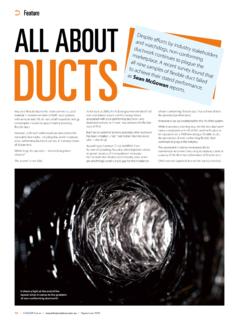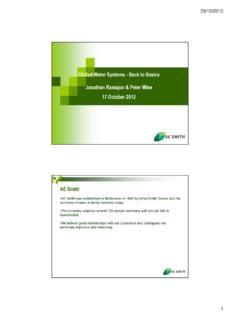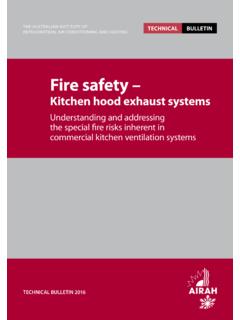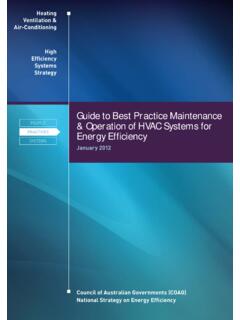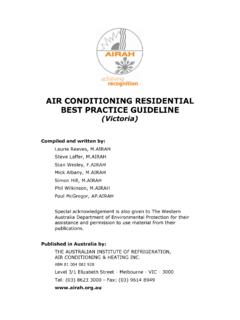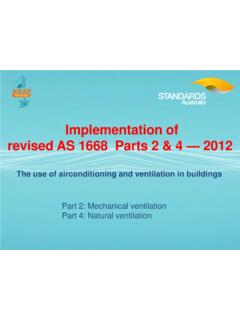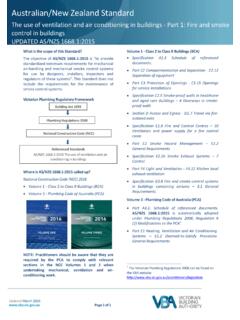Transcription of AIRAH – Refrigeration (in HVAC) Back to Basics
1 AIRAH Refrigeration (in hvac ) Back to Basics For the First Time Terms of Reference What this session is NOT about Detailed Refrigeration Design Detailed analysis of various Refrigants properties Comparison of Natural v Synthetics Comparison of Oil-free v Oiled Energy analysis Component Selections Teaching any of us to be an Expert Terms of Reference What this session IS about Introduction to Refrig SYSTEM Basics Basic understanding For Beginners or occasional designers hvac context really How to know WHEN to seek HELP How not to Shoot one s own foot. Who Talks Everyone Including Ben, Craig and Mike .. (This is a Discussion forum, not a lecture) It s a .. Pressure Enthalpy Chart It s important because ? It s important because ? What it looks like in theory It s a Compressor .. it And then the Refrigerant flows But really the Chart looks a little more like this What is subcooling and why do we need it What is Superheat and why do we want it?
2 Some compressors Some other bits And when we turn it into a PACKAGE it looks like this PACKAGE forwards PACKAGE reverse Compressors Apart from Absorption Chillers, evaporative cooling and other specialised systems, most refrig cycle applications = vapour compression. Reciprocating scroll Screw Centrifugal OIL What purpose does oil serve (primarily) What components does it lubricate How can it move in a closed system Gravity What goes up .. Refrigerant Absorption At any normal temperature, the vapour pressure of the oil in a Refrigeration system is much lower than the vapour pressure of the refrigerant, and during shut down periods, as a result of the miscibility of refrigerant in oil, refrigerant in contact with the surface of an oil pool is absorbed into the oil. Oil pump-out Oil pump-out can occur when sufficient foam is delivered into the system by the compressor at start-up so as to reduce the oil content in the sump to a level too low for effective supply to the compressor s oil pump.
3 REFRIG SYSTEM A properly designed and installed refrigerant piping system should: Provide adequate refrigerant flow to the evaporators, using practical refrigerant line sizes that limit pressure drop Avoid trapping excessive oil so that the compressor has enough oil to operate properly at all times Avoid liquid refrigerant slugging Be clean and dry What happens if the oil is where it should not be System fully charged with refrigerant and oil so how does a bearing go Dry and WELD? Foaming. Oil exclusion. Oil return failure AKA how to make many parts into ONE What happens if the oil is where it should not be Floodback or slugging Liquid IN the compressor be it liquid refrigerant or oil AKA how to make ONE part into MANY REFRIG PIPING SYSTEM A properly designed and installed refrigerant piping system should: Provide adequate refrigerant flow to the evaporators, using practical refrigerant line sizes that limit pressure drop Avoid trapping excessive oil so that the compressor has enough oil to operate properly at all times Avoid liquid refrigerant slugging Be clean and dry McQuay Application Guide AG31-011 REFRIG SYSTEM Traps in Discharge line for this arrangement Where are the traps in the suction line?
4 Hot gas mixing All falls to REFRIG SYSTEM Traps in Suction line for this arrangement Why are there two? All falls to Heat Rejection Remember the p-e chart Total Heat of rejection Rejection to Air is dominated by Dry Bulb temperature Rejection to Water is dominated by the water body temperature or by the approach to Wet-Bulb. Wet Bulb is always colder than dry bulb What does a suction line have to do Suction gas lines allow refrigerant gas from the evaporator to flow into the inlet of the compressor. Undersizing the suction line reduces compressor capacity by forcing it to operate at a lower suction pressure to maintain the desired evaporator temperature. Oversizing the suction line increases initial project costs and may result in insufficient refrigerant gas velocity to move oil from the evaporator to the compressor. This is particularly important when vertical suction risers are used.
5 Basic sizing of a suction line Suction lines should be sized for a maximum of 2 to 3 F ( to C) pressure loss. The actual pressure drop in kPa will depend on the refrigerant. Fall: Suction lines should continously fall in the direction of flow 10mm/m minimum Gas Velocity needs to return oil to the compressor even at low load Velocity > 750 fpm in horizontal, 1500fpm in vertical Use the CHART But then calculate pressure drop for your system Check velocity for oil return How do you get the gas velocity? What does a discharge line have to do Discharge gas lines (often referred to as hot gas lines) allow refrigerant to flow from the discharge of the compressor to the inlet of the condenser. Undersizing discharge lines will reduce compressor capacity and increase compressor work. Over sizing discharge lines increases the initial cost of the project and may result in insufficient refrigerant gas velocity to carry oil back to the compressor.
6 Discharge lines should be sized for no more than 2 to 3 F ( to C) pressure loss. The actual pressure drop in PSI will depend upon the refrigerant. Capacity and power consumption are affected by increasing pressure drop for both discharge and suction lines. SOUND FAMILIAR ? must prevent oil trapping at minimum capacity must prevent backflow of oil or refrigerant to the compressor during low load or shutdown Basic sizing of a discharge line .. Surprise .. Use the CHART But then calculate pressure drop for your system Check velocity for oil return What does a liquid line have to do Transport liquid refrigerant to the metering device Ensure that the fluid entering the metering device is fully liquid phase! (That s why we sub-cool) Prevent heat gain in the refrigerant which would also heighten the risk of flash gas Size a Liquid Line Yes use the charts. Don t forget corrections for temperatures etc Receivers What / Where Systems do not always operate at the same conditions Need to address changing vapour / liquid ratios How does the oil get through the receiver orifices and venturi effect Vapour Migration Vapour Pressure driven Oil is always a lower vapour pressure than the surrounding refrigerant (at rest) Vapour moves to a lower vapour pressure Colder areas of the system Oil resevoirs Just because you collected it in a receiver does not mean it will stay there.
7 Vapour migration during shutdown can lead to catastrophic failures! Now over to Mr Pinder Real life examples REAL LIFE EXAMPLES REAL LIFE EXAMPLES REAL LIFE EXAMPLES REAL LIFE EXAMPLES REAL LIFE EXAMPLES REAL LIFE EXAMPLES REAL LIFE EXAMPLES REAL LIFE EXAMPLES REAL LIFE EXAMPLES REAL LIFE EXAMPLES REAL LIFE EXAMPLES REAL LIFE EXAMPLES A few to finish with It s almost time for What might we change? Discharge Lines should they be insulated or not? Liquid Line? Replace with .. Trapped Insulated What would we change here? Liquid Receiver SubCooled Line Liquid Line Replaced with Liquid Receiver RELOCATED A few to finish with Sub Cooled Liquid Line What does the liquid line have to do? How about here .. Discharge Lines Check Valves Replaced with .. Thanks for your time References McQuay Refrigerant Piping Design Guide References Refrigerant Piping Handbook References ASHRAE HANDBOOK 2 References A bundle of websites for images If we got this far in an hour.
8 How about some rules of Rules of thumb For an R410a hvac system the discharge line should be around 60-70 degrees normal max. If you can touch it for a moment .. it s probably OK. If it SIZZLES there s trouble coming. If you can hold it, don t stand near the compressor the bits coming out might hit you. Rules of thumb The liquid line SHOULD be either close to ambient or close within about 4 degrees of ambient wet bulb for water cooled. If it s hot = not good If there are cold spots on it = not good Rules of thumb Suction Line might show some frosting after the TX. Should NOT be a block of ice. If there s a block of ice on the evap coil again don t stand near the compressor. The suction line coming out of the evap should never be frosted Rules of thumb Coil, compressor and Condenser sizing = Contact an expert! Do NOT forget that your Saturated Temperatures have CHANGED between compressor and condenser and between condenser and TX This changes capacity!
9
